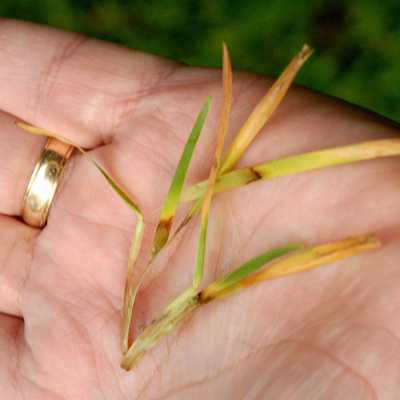Perhaps Early Arrival of Brown Patch*
* Note: Texas A&M turf and plant pathology specialists are shifting toward calling this disease “large patch” (Rhizoctonia solani). Historically I have tried to follow their lead all of the time, but this old habit is going to take me a bit longer to break. So that you won’t think that I’ve headed off in a random direction, I will continue to refer to it as “brown patch” in this write up. As time passes, I’ll try to introduce the new term gradually. Goodness knows, St. Augustine already has enough disease problems to its credit. This is not a new one. Just a new name for an old one.
If you have a St. Augustine lawn, you need to be on the lookout for brown patch fungus every autumn. It’s about as much a fixture of fall as pumpkins and apple cider. (Brown patch will also show up in zoysia and fescue turf, although St. Augustine is our main focus here.)

The first thing you’ll notice once you learn to look for brown patch will be yellowing blades in circular areas about the size of a garbage can lid. You’ll almost find yourself imagining them at the outset.
At that point you have a couple of options. You can pull on some of the yellowing blades and check them individually, or you can wait a few days and find out for sure. The first option is definitely better.

The brown patch fungus attacks the blades at their bases, right where they attach to the runners. They will pull loose easily from the runners, almost like tearing wet facial tissues apart. You will be able to see the browned, decaying leaf tissues.

At that point you need to go into action. Stop all evening and night irrigation. Wet grass promotes the disease. Irrigate in early morning hours.
Apply a fungicide labeled for patch diseases of turfgrasses. As with take all root rot and gray leaf spot, Azoxystrobin is listed. It’s sold as Scotts Disease EX. The brown patch may continue to get worse for a few days, but no new patches should appear. Since brown patch is a leaf disease only, the runners and roots remain healthy, and it is customary that new growth will be produced if there is time enough before frost.
Brown patch does not kill St. Augustine, but it does weaken the grass. In the northern parts of its region, St. Augustine can be damaged by extreme winter temperatures, and those sections that have been hurt by brown patch will be more likely to be damaged. As a result, you do want to stop it as quickly as possible.
Note: Here is a very helpful new bulletin on “St. Augustine Lawn Management” from Texas A&M by Extension Turf and Urban Water Specialists Drs. Chrissie Segars and Becky Bowling.
